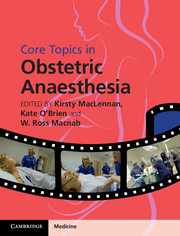Book contents
- Frontmatter
- Contents
- List of contributors
- Preface
- Section 1 Basic science, epidemiology and service organization
- Section 2 Obstetric aspects
- Section 3 Provision of anaesthesia
- Section 4 Medical conditions in pregnancy
- 14 Hypertension in pregnancy, pre-eclampsia and eclampsia
- 15 Sepsis and influenza in pregnancy
- 16 Cardiac disease in pregnancy
- 17 Respiratory disease in pregnancy
- 18 Obesity and ultrasonography for central neuraxial blocks
- 19 Endocrine disease in pregnancy including diabetes mellitus, thyroid and adrenal disease
- 20 Renal disease
- 21 Haematologic disease in pregnancy
- 22 Neurosurgical and neurological disease in pregnancy
- 23 Immunology, including testing and management of allergy during pregnancy
- 24 HIV and infectious disease in pregnancy, including herpes, syphilis and hepatitis
- Section 5 Postpartum complications and obstetric emergencies
- Section 6 Service organization
- Index
- Plate section
- References
23 - Immunology, including testing and management of allergy during pregnancy
from Section 4 - Medical conditions in pregnancy
Published online by Cambridge University Press: 05 December 2015
- Frontmatter
- Contents
- List of contributors
- Preface
- Section 1 Basic science, epidemiology and service organization
- Section 2 Obstetric aspects
- Section 3 Provision of anaesthesia
- Section 4 Medical conditions in pregnancy
- 14 Hypertension in pregnancy, pre-eclampsia and eclampsia
- 15 Sepsis and influenza in pregnancy
- 16 Cardiac disease in pregnancy
- 17 Respiratory disease in pregnancy
- 18 Obesity and ultrasonography for central neuraxial blocks
- 19 Endocrine disease in pregnancy including diabetes mellitus, thyroid and adrenal disease
- 20 Renal disease
- 21 Haematologic disease in pregnancy
- 22 Neurosurgical and neurological disease in pregnancy
- 23 Immunology, including testing and management of allergy during pregnancy
- 24 HIV and infectious disease in pregnancy, including herpes, syphilis and hepatitis
- Section 5 Postpartum complications and obstetric emergencies
- Section 6 Service organization
- Index
- Plate section
- References
Summary
Introduction
This chapter focuses on allergic diseases and their relevance to obstetric anaesthesia, with practical advice on management. Ideally, parturients with suspected allergic disease should be assessed prior to pregnancy, in order to identify relevant allergens and to confirm a management plan. Parturients with a history suggestive of adverse drug reaction require further investigation to identify the cause or to exclude allergy. A previous perioperative or peripartum adverse event necessitates review of those anaesthetic and medical records. If a patient has experienced a serious adverse reaction, their notes should be clearly marked with drug allergy information and a hazard-warning bracelet advised.
Pregnancy presents other immunological challenges to the mother and semiallograft fetus. For the pregnancy to succeed, local and systemic immunological changes are required, including reduction in cytotoxic adaptive immunity and enhancement of regulation. The systemic impact of the immunological changes is not clear, but there is an increased risk of atopic and autoimmune dermatoses in pregnancy. There is no clear evidence to suggest that general atopic diseases are affected.
Autoimmune diseases can have a significant impact on pregnancy, particularly when autoantibodies directed against phospholipids, SS-A or SS-B are present. Antiphospholipid syndrome is associated with increased risk of pregnancy morbidity and loss. The presence of antibodies directed against SS-A and/or SS-B is associated with neonatal lupus and congenital heart block. The effect of pregnancy on the course of autoimmune diseases is more variable, with both improvement and deterioration reported without consistency.
Immunodeficiency syndromes may also present challenges in pregnancy. Patients with antibody deficiency syndromes will have increased requirements of immunoglobulin replacement in the third trimester of pregnancy due to active transplacental transfer of immunoglobulin G. Patients with hereditary angioedema (HAE) may improve, remain stable or deteriorate during pregnancy and should receive prophylactic treatment before any instrumental delivery or surgical procedure. Increased vigilance through pregnancy and during delivery is therefore advised for most patients with pre-existent immunologically mediated diseases.
Allergens relevant to anaesthesia
A perioperative allergic reaction is often attributed to drugs, chlorhexidine or latex exposure.
Taking a clinical history for drug allergy
Type I hypersensitivity (IgE-mediated) is often considered to be true allergy. See Table 23.1.
Many patients report allergy to medications: 10% of hospital inpatients self-report penicillin allergy; 90% of patients self-reporting penicillin allergy are able to tolerate penicillin on challenge without adverse reaction (see Box 23.1 and Figure 23.1).
- Type
- Chapter
- Information
- Core Topics in Obstetric Anaesthesia , pp. 176 - 184Publisher: Cambridge University PressPrint publication year: 2015



